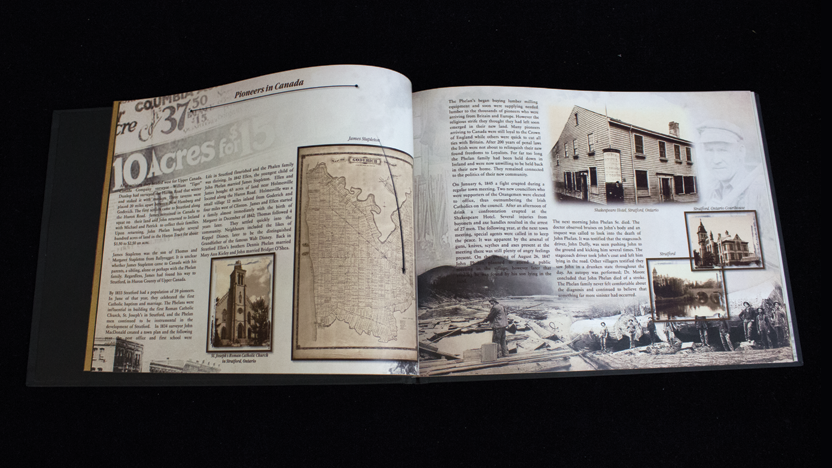What You Need to Know Before Writing Your Family Business History Book
May 4, 2022
Family-run businesses have been the backbone of the American economy for decades. A business is a source of pride for countless families, a great number of which go on to become well-established corporations. Some family companies even endure the test of time as they move from generation to generation.
When businesses grow and thrive over the years and decades, they accumulate valuable experiences and stories. However, these memories may fade as time wears on. It then becomes essential to preserve the company’s history by honoring its founders and contributors.
The question is, how can current business stewards properly preserve their company’s history?
In this article, we will explore five things to know about writing a family business history book as well as effective ways of crafting a document that depicts a family-run corporation’s true nature and character.
Defining a Family Business History Book
Before defining what a family history book is, it is worth defining what it is not.
A family business history book is not a list of facts, dates, and names.
While there is certainly a place for timelines, charts, and chronology, a family history book should be about building a coherent narrative around the company’s journey and the family behind it.

When business leaders limit their family business history book to a collection of factual information, they deprive readers of the company’s essence. In other words, the formula that made the company successful gets lost along the way.
So, what exactly is a family business history book?
A family business history book is a living document. It is a testament to the company’s evolution. Therefore, the narrative must reflect the business’s transition and the contributions of those who made it possible.
Benefits of Writing a Family History Book
There are three key benefits to consider when evaluating a potential family business history book.
1. Preserving a Legacy
Undoubtedly, the biggest benefit is also the biggest motivating factor. Business leaders must consider the importance of preserving the legacy of both their family and their business. Thus, writing a family business history book ensures that generational efforts endure into the future and beyond.
2. Honoring Founders

A successful family business would not exist without courageous founders.
Indeed, a family business history book should pay homage to the founder’s valuable contributions.
Moreover, a family business history book should honor significant contributions from subsequent generations.
After all, the business would not continue to thrive without each generation’s noteworthy efforts.
3. Celebrating Achievements
A family business history book should also celebrate achievements. In particular, achievements by the company and its founders can make up the core narrative. A family history book can provide wonderful insight into the company’s overall contribution and its collaborators’ role by celebrating achievements.
Please bear in mind that effective family business history books address challenges and failure as part of the evolution process. These experiences can serve to describe worthwhile lessons that helped the company and its founders build a robust enterprise. Moreover, readers love learning about how successful leaders overcome their challenges.
Getting Started With a Family Business History Book
Getting started with a family business history book may seem like a daunting task. However, it is not. Far from it. Writing a family business history book is relatively straightforward when business leaders take the proper steps. As a result, there are five key elements to consider when writing a family business history book.
1. Plan carefully.
The first step to writing a family business history book is to collect information. Without careful planning, it may be hard to differentiate useful information. Typically, the information-gathering process yields voluminous results. Sorting the information can become a complex task.
To streamline the information collection process, family business book authors must carefully plan the approach they wish to take. This planning process includes building a narrative and establishing the main events and people throughout the company’s history.
A great technique to use is mind-mapping.
In mind-mapping, writers use a diagram to visually organize information in a hierarchy, showing relationships among pieces of the whole.
This helps narrow the focus into a single overarching theme.

Mind-mapping can be as simple or as complex as needed.
For instance, a simple mind map can provide the book’s broad outlines and main topics. More complex mind maps can delve into the specific points surrounding the book.
Generally speaking, the planning process should guide family business history authors throughout the information collection process. Careful planning enables authors to determine what information is useful to support the book’s narrative. Additionally, careful planning eliminates pursuing tangents that may do little to build the intended narrative.
2. Highlight the company’s ethos.
The planning and outlining process must highlight a crucial element: the company’s core ethos. In general, a company’s core ethos is the basis of its mission and vision statements. Therefore, a solid family business history book must reflect this core ethos.
However, authors must ensure they accurately depict the founders’ original vision for the company. The book’s narrative can then describe how the company’s mission and vision have evolved throughout time. This approach helps readers see how the company’s core values enabled it to thrive.
It is also worthwhile to demonstrate how the vision of individuals has helped shape the company’s ethos. Often, companies revolve around the founders’ original vision. For example, founders start a business looking to serve a specific type of customer. Also, founders seek to deliver value and support their communities. These motivations must jump out at readers as they navigate the company’s history.
3. Mind the details.
A common mistake is to attempt to chronicle every detail of the company’s history.

While readers would certainly appreciate detailed accounts, providing too much detail may lead to a copious amount of information.
Therefore, minding the details becomes a crucial factor in establishing the book’s overall construction.
Here are some points to ponder:
- Will the book provide an overview of the company’s history? If so, what are the most important events the narrative will revolve around? These are the points that require the most details. Other events may not require highly detailed depictions.
- Will the book center on a specific event? If so, the surrounding narrative should only provide context to the book’s main point. For example, a book that focuses on a specific product’s success can offer details on other events to give readers context leading up to the product launch. From there, the narrative can go into greater depth regarding the product’s creation, development, and launch.
- Will the book focus on its founders and their role in the company? If so, details on the people must reflect their influence on events. Therefore, chronicling specific events in detail should serve to illustrate the founders’ influence.
- Will the book’s narrative be part of a broader social or historical context? If so, details about the social and historical context must link to the company’s history. For example, a family business history book about a company surviving the Great Depression must link the company’s survival to the overall challenges businesses faced during the Great Depression.
On the whole, it is crucial to avoid providing too many inconsequential details. The aim should be to produce a sharp narrative that will keep readers turning pages. Details must, therefore, provide the right amount of information while keeping readers interested in the book’s next portion.
4. Focus on the right people.
When writing a family business history book, it is easy to focus on the founders and neglect other valuable contributors. Thus, authors must ensure they include everyone’s contributions. While founders are crucial to the narrative, other contributors, such as employees, suppliers, customers, or local government officials, may have played a significant role in the company’s success. These contributions should make up the book’s narrative whenever they are relevant.
Likewise, it is crucial to avoid listing people without reflecting on their importance to the company. Hence, it is best to avoid listing people unless their contributions have somehow influenced the company. Readers want to know why the business has been successful and the people that have made it possible.
5. Say it with pictures.
Carefully curated pictures speak volumes about a family business’s history. Pictures provide depth and substance to the book’s overall narrative. After all, it is one thing to portray events with words, but a completely different situation emerges when using imagery.
Effective use of pictures allows readers to put faces to names. It also helps readers see the company’s evolution.
For instance, a common use of pictures is to show the evolution of store locations or products. These transitions help readers grasp the thoughts and emotions behind the descriptions in the narrative.

It is also important to avoid including pictures for the sake of it.
Including random or unrelated pictures, while entertaining, may contribute little to the book’s substance.
Thus, selecting pictures based on the mind map and outline will go a long way toward conveying the right company image.
Hiring a Ghostwriter to Write a Family Business History Book
There are instances where putting pen to paper can be a considerable challenge.
For instance, business leaders may not have the time or expertise to write a full-length book. Also, organizing, cataloging, and utilizing information can prove to be a complex and time-consuming endeavor. Additionally, some folks find that writing is not their strong suit.
What can business leaders do in these situations?
This is where it pays to hire a ghostwriter.
Ghostwriters are professional scribes that can take archival information and transform it into a seamless narrative. They have the expertise and experience to transform pictures, dates, names, and stories into a carefully woven quilt of emotions, events, and accomplishments.
How can one hire the right ghostwriter?
Hiring the right ghostwriter for a family business history book depends on experience and know-how. Thus, reaching out to individual ghostwriters and ghostwriting firms is only the first step.
Business leaders must take the time to interview prospective ghostwriters and ghostwriting firms. These interviews should allow business leaders to ascertain a ghostwriter’s overall suitability for the project.
Finding the right ghostwriter may take some time. However, taking the time and effort to find the perfect ghostwriter will eventually pay off in droves. After all, the alternative to foregoing a ghostwriter is letting a family business history book project stagnate.

When projects simply stall, it can be nearly impossible to revive them. It is, therefore, essential to consider employing a ghostwriter before the writing project languishes into oblivion.
Please bear in mind that the most significant benefit of hiring a ghostwriter is the savings in time and effort.
Unless one is willing to devote the time and effort needed to produce a full-length family business history book, hiring a professional ghostwriter may be the best way to see the project to fruition.
Conclusion
Writing a family business history book is no easy task. It is a labor of love.
Indeed, producing a high-quality family business history book is about finding a balance between accurate information and a compelling narrative. Ultimately, careful planning and thoughtful information gathering make striking this balance possible.
The most important element to consider is planning. Careful planning provides organization and clarity when pursuing a family business history book project. This clarity helps sort through large amounts of information, allowing authors to find the most suitable information for the project.
Employing a professional ghostwriter is a worthwhile consideration, especially when business leaders lack the expertise, time, or experience to produce a full-length book. A professional ghostwriter can weave various information sources into a seamless tale. Thus, employing a professional ghostwriter can differentiate between a stalled project and a completed chronicle.
Lastly, a family business history book should pay homage to the people who made the business grow and thrive. It is about preserving a legacy, enabling it to endure through subsequent generations. Moreover, a lasting legacy involves handing down valuable knowledge to future generations. After all, one cannot know where they are going if they do not know from where they came.